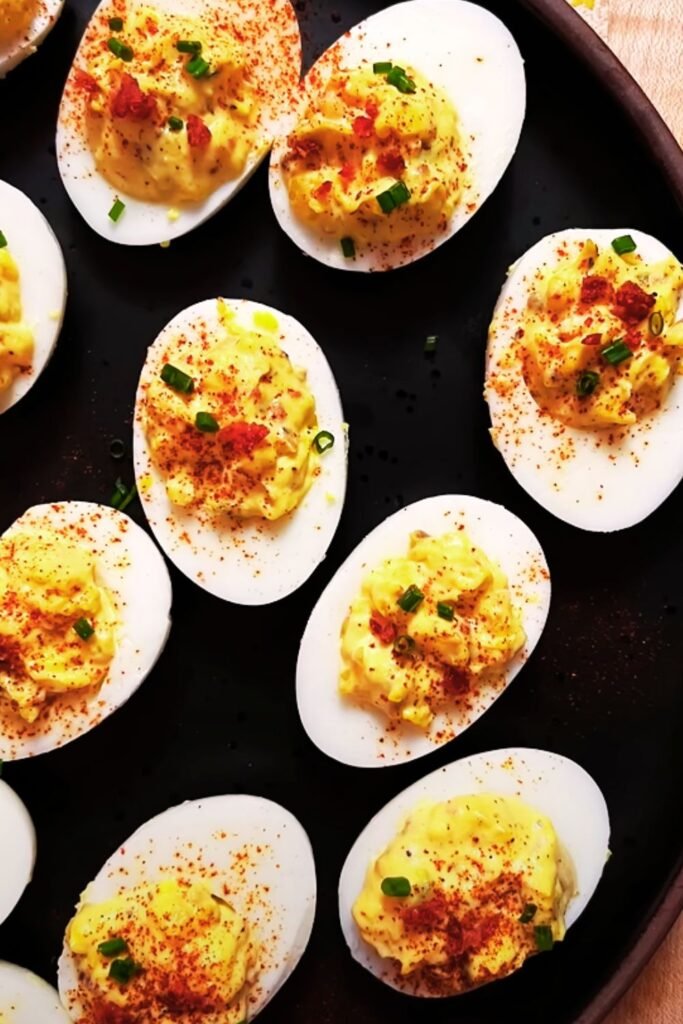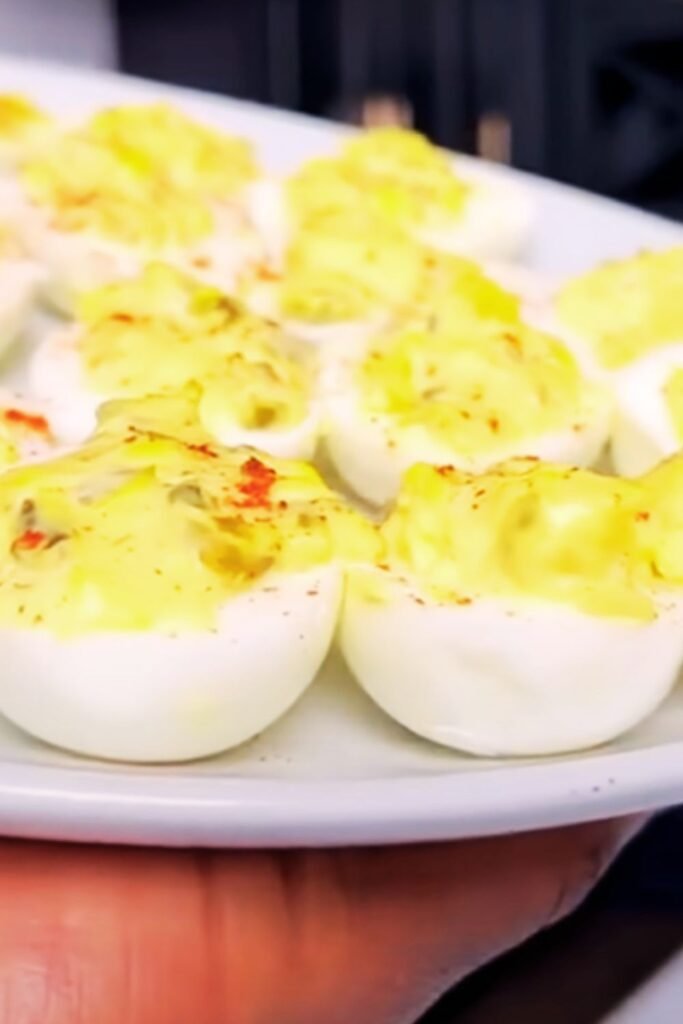I’ve been perfecting my deviled egg recipe for over a decade, and let me tell you – there’s something magical about these bite-sized appetizers that never fails to disappear from any gathering. Whether I’m hosting a backyard barbecue, attending a potluck dinner, or simply craving a protein-packed snack, my classic deviled eggs have become my go-to crowd-pleaser.
The beauty of deviled eggs lies in their simplicity and versatility. With just a handful of pantry staples, I can create an elegant appetizer that looks sophisticated yet feels comfortably familiar. Every time I bring these to a party, I watch as people’s faces light up with nostalgic recognition – there’s something deeply satisfying about that first creamy, tangy bite.
The Foundation: Perfect Hard-Boiled Eggs
Before I dive into the creamy filling, I need to address the foundation of any great deviled egg – the perfectly cooked hard-boiled egg. After countless experiments and kitchen disasters, I’ve discovered that achieving that ideal texture requires precision and patience.
My method begins with room temperature eggs, which I’ve found prevents cracking during the cooking process. I place them in a single layer in my saucepan, covering them with cold water by about an inch. The key insight I’ve learned is to bring the water to a rolling boil, then immediately remove the pot from heat and cover it tightly.
The Science Behind Perfect Timing
The timing for my hard-boiled eggs depends on the final texture I’m seeking:
Cooking Time Guidelines:
- 10 minutes: Firm whites with slightly soft centers (my personal preference for deviled eggs)
- 12 minutes: Completely set yolks with creamy texture
- 15 minutes: Very firm yolks (better for chopped egg salad)
I always follow the cooking with an immediate ice bath plunge. This shock stops the cooking process and makes peeling infinitely easier. There’s nothing more frustrating than losing half the egg white to stubborn shells, and this technique has saved me countless times.
My Classic Deviled Egg Recipe
After years of tweaking and adjusting, I’ve landed on this foolproof recipe that delivers consistently creamy, flavorful results every single time.
Essential Ingredients
| Ingredient | Quantity | Purpose | Quality Tips |
|---|---|---|---|
| Large eggs | 12 | Base structure | Choose eggs at least 1 week old for easier peeling |
| Mayonnaise | 6 tablespoons | Creamy binding agent | Use full-fat for best texture |
| Yellow mustard | 1 teaspoon | Tangy flavor base | Dijon works as substitute |
| Sweet pickle relish | 2 teaspoons | Texture and sweetness | Drain excess liquid |
| Apple cider vinegar | 1/2 teaspoon | Brightness and preservation | White vinegar acceptable |
| Salt | 1/4 teaspoon | Flavor enhancement | Fine sea salt preferred |
| Black pepper | 1/8 teaspoon | Warm spice note | Freshly ground recommended |
| Paprika | For garnish | Visual appeal and mild flavor | Sweet Hungarian variety |
Step-by-Step Preparation Method
Cooking the Eggs:
- I start by bringing my eggs to room temperature, which takes about 30 minutes on my counter
- Place eggs in a single layer in my heavy-bottomed saucepan
- Cover with cold water by 1 inch above the eggs
- Bring to a vigorous rolling boil over high heat
- Remove from heat immediately and cover tightly with lid
- Let stand exactly 10 minutes for my preferred texture
The Ice Bath Process: While my eggs cook, I prepare a large bowl with ice water. The moment that 10-minute timer goes off, I transfer each egg with a slotted spoon directly into the ice bath. This dramatic temperature change makes the shells practically fall off during peeling.

Creating the Filling: After my eggs have cooled completely (about 15 minutes in the ice bath), I carefully peel each one under cool running water. I slice each egg lengthwise with a sharp knife, removing the yolks into my mixing bowl.
The yolk mixture becomes my canvas for flavor. I mash the yolks with a fork until they’re completely smooth – no lumps allowed in my deviled eggs! Then I incorporate each ingredient methodically: mayonnaise first for the creamy base, followed by mustard for tang, pickle relish for texture, vinegar for brightness, and finally salt and pepper to taste.
Mastering the Perfect Consistency
The texture of my deviled egg filling has taken years to perfect. I’ve learned that the mixture should be smooth enough to pipe beautifully, yet substantial enough to hold its shape. If my filling feels too thick, I add mayonnaise one teaspoon at a time. If it’s too loose, I incorporate additional mashed yolk or even a small amount of cream cheese.
My secret weapon for ultra-smooth filling is passing the yolk mixture through a fine-mesh sieve. This extra step eliminates any remaining lumps and creates an almost mousse-like consistency that elevates the entire appetizer.
Creative Variations I Love
While my classic recipe remains my foundation, I’ve developed several variations that keep things interesting:
Bacon Deviled Eggs
I fold in 4 strips of crispy bacon, finely chopped, along with a touch of smoked paprika. The smoky, salty elements create an irresistible combination that disappears even faster than my classic version.
Herb Garden Deviled Eggs
Fresh chives, dill, and parsley transform my basic recipe into something garden-fresh and vibrant. I use about 2 tablespoons of mixed herbs, finely minced, and reduce the pickle relish slightly to maintain balance.
Spicy Sriracha Deviled Eggs
For those who enjoy heat, I incorporate 1-2 teaspoons of sriracha sauce and garnish with a tiny drizzle on top. The sweet heat pairs beautifully with the creamy egg base.

Presentation and Serving Techniques
The visual appeal of my deviled eggs matters almost as much as the taste. I’ve invested in a proper deviled egg plate with individual wells, which keeps each egg steady and creates an elegant presentation.
Professional Piping Methods
For filling the egg whites, I have two preferred methods:
Method 1 – Piping Bag: I transfer my filling to a piping bag fitted with a large star tip. This creates beautiful, professional-looking swirls that add height and visual interest.
Method 2 – Zip-Lock Bag: When I don’t have a piping bag handy, I use a sturdy zip-lock bag with one corner snipped off. While not as decorative as a star tip, this method still provides better control than spooning.
Garnish Guidelines
| Garnish Type | Visual Impact | Flavor Contribution | Application Method |
|---|---|---|---|
| Sweet paprika | Classic orange-red color | Mild, sweet pepper | Light dusting with fine sieve |
| Smoked paprika | Deeper, richer red | Smoky, complex flavor | Pinch on each egg |
| Fresh chives | Bright green contrast | Mild onion flavor | Finely chopped, sprinkled |
| Crispy bacon bits | Texture and color variety | Salty, smoky crunch | Small pieces, 2-3 per egg |
| Capers | Sophisticated appearance | Briny, tangy pop | 1-2 per egg, drained |
Storage and Food Safety Considerations
Food safety with deviled eggs requires careful attention, especially since they contain mayonnaise and eggs – both ingredients that can harbor bacteria if not handled properly.
I always prepare my deviled eggs no more than 24 hours in advance. They stay freshest when I store the filled eggs in an airtight container in my refrigerator at 40°F or below. For transport to parties or events, I use a cooler with ice packs and never leave them at room temperature for more than 2 hours.
Make-Ahead Strategies
When I’m planning for large gatherings, I use this timeline:
- 2 days ahead: Cook and peel eggs, store whole in refrigerator
- 1 day ahead: Prepare filling, fill eggs, cover and refrigerate
- Day of serving: Add final garnishes and bring to room temperature for 15 minutes before serving

Nutritional Benefits and Dietary Considerations
My classic deviled eggs offer impressive nutritional value. Each egg provides high-quality complete protein, essential vitamins like B12 and choline, and healthy fats. The addition of mustard contributes selenium and turmeric compounds, while pickle relish adds a small amount of probiotics.
Nutritional Breakdown Per Serving (1 deviled egg half)
| Nutrient | Amount | % Daily Value |
|---|---|---|
| Calories | 78 | 4% |
| Protein | 6.2g | 12% |
| Fat | 5.8g | 9% |
| Carbohydrates | 0.8g | <1% |
| Cholesterol | 186mg | 62% |
| Sodium | 124mg | 5% |
| Vitamin B12 | 0.6mcg | 25% |
| Choline | 147mg | 27% |
Troubleshooting Common Issues
Throughout my deviled egg journey, I’ve encountered and solved numerous challenges that seem to plague home cooks:
Green Ring Around Yolks: This occurs from overcooking. I prevent this by timing precisely and using the ice bath immediately.
Difficult-to-Peel Eggs: Fresh eggs are the culprit. I always use eggs that are at least one week old, and the ice bath technique makes a dramatic difference.
Runny Filling: Too much liquid ingredient. I fix this by adding more mashed yolk or a small amount of cream cheese to thicken.
Lumpy Texture: Insufficient mashing or mixing. I always sieve my yolk mixture for ultra-smooth results.
Bland Flavor: Under-seasoning is common. I taste and adjust salt, mustard, and vinegar until the flavor pops.
Serving Suggestions and Pairings
My deviled eggs complement a wide variety of dishes and occasions. They work beautifully as part of a Southern-style spread alongside fried chicken, coleslaw, and cornbread. For more elegant gatherings, I serve them with smoked salmon pinwheels and cucumber sandwiches.
The key to successful pairing lies in balancing richness with lighter elements. Since deviled eggs are inherently creamy and substantial, I like to offer fresh vegetables, crisp crackers, or light salads as accompaniments.
For outdoor gatherings, they pair wonderfully with grilled meats, potato salad, and fresh fruit. The protein content makes them particularly satisfying for brunch spreads, where I often serve them alongside fresh pastries and seasonal fruit salads.
Questions and Answers
Q: How far in advance can I make deviled eggs? I recommend making them no more than 24 hours ahead for the best texture and food safety. The filling can become watery if prepared too early, and the egg whites may develop an unpleasant texture.
Q: Why do my deviled eggs taste bland? Under-seasoning is the most common culprit. Make sure you’re tasting the filling before piping and adjust salt, mustard, and vinegar accordingly. Don’t forget that cold foods need more seasoning than warm ones.
Q: Can I freeze deviled eggs? I don’t recommend freezing deviled eggs. The mayonnaise-based filling separates when frozen and thawed, creating an unappetizing texture. They’re best enjoyed fresh or within 2-3 days of preparation.
Q: What’s the secret to smooth, creamy filling? My secret is passing the yolk mixture through a fine-mesh sieve after mixing. This eliminates any lumps and creates a professionally smooth texture. Also, make sure your eggs are completely cooled before mashing the yolks.
Q: How do I prevent the green ring around the yolks? The green ring forms when eggs are overcooked or cooled too slowly. I prevent this by timing exactly 10 minutes and immediately transferring to an ice bath. The rapid cooling stops the cooking process.
Q: Can I make deviled eggs without mayonnaise? While mayonnaise provides the classic creamy texture, you can substitute with Greek yogurt, avocado, or a combination of sour cream and cream cheese. Each substitute will create a slightly different flavor profile and texture.
Q: Why won’t my egg shells peel easily? Very fresh eggs are notoriously difficult to peel. I always use eggs that are at least one week old, bring them to room temperature before cooking, and use the ice bath method immediately after cooking.
Q: How many deviled eggs should I plan per person? For appetizers, I typically plan 2-3 deviled egg halves per person. If they’re part of a larger spread with many options, 1-2 per person is usually sufficient. For deviled egg enthusiasts, I always make extra!
Q: What’s the best way to transport deviled eggs? I use a specialized deviled egg carrier or a regular container with dividers. Keep them cold with ice packs in a cooler, and don’t leave them at room temperature for more than 2 hours for food safety.
Q: Can I make deviled eggs with different types of eggs? While chicken eggs are traditional, I’ve successfully made deviled eggs with duck eggs (which are richer) and quail eggs (which make elegant bite-sized appetizers). Cooking times may need adjustment based on egg size.
My journey with deviled eggs has taught me that perfection comes through practice and attention to detail. Each element – from the perfectly cooked egg to the creamy, well-seasoned filling – contributes to creating an appetizer that never goes out of style. Whether I’m making them for a casual family gathering or an elegant dinner party, these classic deviled eggs consistently deliver the comfort and satisfaction that keeps everyone coming back for more.